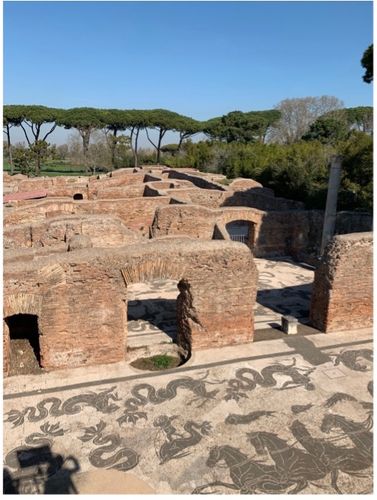
This Sunday we will begin our post-Pentecost focus on Jesus and his encounters with people around him, teaching them how their pre-conceived notions and expectations don’t always fit into the kingdom of God. When he heals on the Sabbath, he is confronted by religious leaders who claim that he is violating the 4th commandment. “Characteristically, Jesus’ response turns the accusation upside-down, not only is the Sabbath a gift given to humanity, but if Jesus is “Son of Man’ and “Lord of the Sabbath”, then it is his gift that the religious leaders are turning into a millstone.” (Sunday by Sunday Issue 83 Royal School of Church Music) This photo is one that I took in 2023 of the ancient port of Rome in Ostia Antica.
Our Processional hymn will be Christ, whose glory fills the skies, written by Charles Wesley in 1740. Wesley titled the text, Morning Hymn, and it is unusual because it doesn’t contain the customary reference to the previous night’s rest or to the work and dangers of the day ahead. The text begins by placing the focus entirely on Christ, the Light of the World, the sun of righteousness who rises with healing in his wings; he is the Dayspring and Daystar. Thus the light of Christ is to fill our lives and lead us forward to the perfect day. (Psalter Hymnal Handbook; hymnary.org)
The Offertory, When you, Lord, walked through Sabbath fields, was written by Sylvia G. Dunstan in 1991. After a brief, arduous battle with liver cancer, she died in 1993 at the age of 38. For thirteen years, Dunstan had served the United Church of Canada as a parish minister and prison chaplain. She is remembered by those who knew her for her passion for those in need, her gift of writing, and her love of liturgy. She wrote at least 45 hymns, several of which we have sung in worship. This hymn reflects our Gospel reading in Mark 2 about Jesus teaching his disciples about the Sabbath as they walked through the grain fields. When you, Lord, walked through Sabbath fields of rising, ripened grain, your people ate the gracious yield that filled their hearts again. But following eyes watched every hand; the scribes could not believe That you would simply change their ban to let the poor receive. Where, Savior, do you walk today, which field or road or street? Whom do you touch along the way? What anger do you meet? O Christ, when you walk through our fields let us be by your side To learn from those you’ve fed and healed the love that you provide. (1991 GIA Publications, Inc.; Sing! A New Creation; hymnary.org) It is sung to the beautiful hymn tune Morning Song.
Our final hymn will be one that the congregation loves to sing: Here I Am, Lord. It was written in 1981 by Daniel Schutte, who is a Jesuit who tours as a Christian concert artist. The point of view changes between each stanza and the refrain. The stanzas take the perspective of God, while the refrain comes from us, the singers of the hymn offering ourselves to God. Each stanza ends with the question, Whom shall I send? followed by the clear declaration Here I am, Lord. May each of us be stirred to ask ourselves how we can serve in God’s kingdom each day this week. (Dr. Hawn; umcdiscipleship.org)